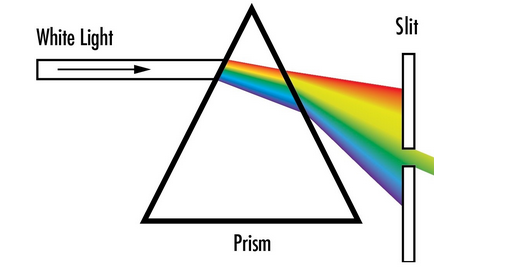The aim of this blog is to create prior art for a dispersive rotating prism spectrometer.
My inspiration here comes from Jerry de Vos. Jerry de Vos is working on a plastic scanner. This project aims to develop a simple handheld scanner that can detect five different types of plastic.
At its core, it contains a photodiode and 8 leds emmiting specific wavelengths2 of near-infrared light. By flashing each LED individually onto a plastic sample and measuring it's reflectance with the photodiode, we obtain its (discrete) reflectance spectra.
Like Hackaday, I am sceptical of the project. Jerry has been able to reach a large audience.
Let's look at a dispersive infrared spectrometer:

Broadly speaking, all optical spectrometers consist of an entrance slit (1), a diffraction grating or prism (2), a detector (3), and routing optics (4). The entrance slit allows light into the spectrometer, where a system of mirrors or lenses routes it first onto a diffraction grating or prism, and then onto the detector. The grating or prism splits the light into its constituent wavelength components, and the detector records the light intensity as a function of wavelength. If the spectrometer has a large spectral range, it may also have filters to stop higher order light from reaching the sensor (source).
A prism where opposing sides are not parallel refracts lights as follows. Key here is that each wavelength is refracted differently, due to dispersion.
 So far I have used prism with an even number of sides. Prisms with an odd number of sides are
So far I have used prism with an even number of sides. Prisms with an odd number of sides aretypically more disperse and deemed undesired for my application.
I am not aware of a dispersive spectrometer where the prism is rotated.
As such, I claim a device used for spectrometry where the prism has uneven sides and is rotated.
As application domain, I claim all the uses of spectrometers prior to march 10 2023.
As shown on this blog, I claim the prism is rotated using a PCB motor or BLDC motor.
Furthermore, I claim the position of the prism is tracked using hall sensors and or optically via a laser or led.
The laser is incident onto the prism on any from the sides. Its reflection is captured by a photo diode and used to monitor the position the prism is in.
Light is shined onto the sample by an external source. Preferably this has a broad spectrum and uniform angle of incidence. The spectrum and the angle of incidence need to be known. One could collimate the light source or use multiple light sources.
A slit or lens might be used to get the light into the spectrometer and ensure a certain angle of incidence.
A slit might further be used to narrow the detection by the detector, used to detect the incident light.
There are a couple of nice things of this technique. The prism can be made really small. Prisms of 1 mm size exist.
The prism could also have three unequal angles so that each sides works slightly different.
There are a lot of complexities; rotating the prism, developing an algorithm to collect the data and making it cheap.
These have been solved by the open hardware laser prism scanner project.
 Hexastorm
Hexastorm
Discussions
Become a Hackaday.io Member
Create an account to leave a comment. Already have an account? Log In.